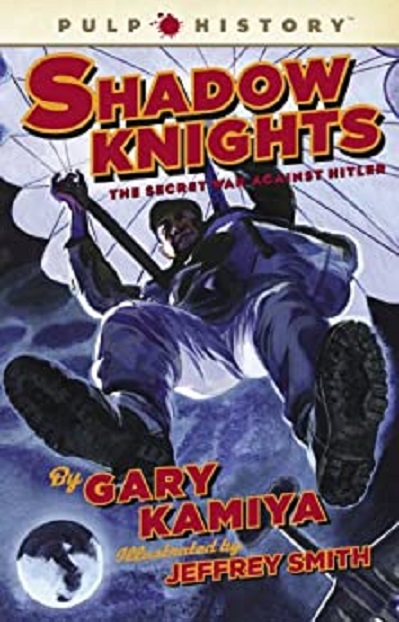Book Review: Shadow Knights: The Secret War Against Hitler written by Gary Kamiya, illustrations by Jeffrey Smith
In 1940, things were looking pretty bleak for Great Britain. Nazi Germany had swept the continent of Europe, all countries there either under its control, that of Fascist Italy, or staying neutral to avoid invasion. The Americans weren’t coming into the war any time soon, and while an invasion of Britain was strategically unlikely, the Luftwaffe could certainly try to bomb it flat. Part of what was needed was a way to get information out of Europe, saboteurs in, and encourage resistance against the German invaders. Thus Winston Churchill authorized the formation of the Special Operations Executive.

This shadowy organization, separate from military intelligence, recruited “ordinary” people. British civilians, refugees from occupied Europe, even criminals were recruited, trained in the dirty business of espionage, and smuggled into enemy territory. This book tells some of their stories.
The focus is on three of those stories: socialist schoolteacher Harry Ree, the Norwegian commando team that took out the Nazi capacity for making “heavy water” (vital to atomic research), and Sufi children’s book author Noor Inayat Khan. Between these stories is a general history of the SOE and how it was set up, and sidebars on various related topics.
This book is part of the “Pulp History” line of history books, which focus on exciting “action” moments in history in hope of getting people to learn about the past who might be put off by more scholarly texts. Thus the emphasis on people’s stories, and the illustrations recreating various moments. (In addition to photographs and documents from the time period.)
As I’ve mentioned before, the British were the producers of the world’s best spy novels, not the world’s best spies. The SOE was hastily cobbled together, and many of its management personnel were at best eccentric, while others were outright incompetent. Refusal by the rear echelon to believe that the Germans had captured and “turned” or impersonated some early agents resulted in many more SOE spies being caught and imprisoned or killed. There was constant danger to the agents in the field not just from the Axis soldiers, but from civilian collaboraters and even people in their own networks due to leaky security.
The Norwegian commandoes succeeded in their mission and remaining alive and uncaptured, a near thing given the harsh Norwegian climate in the areas between them and safety. Mr. Ree was badly wounded, but was able to escape. Ms. Khan was executed at Dachau.
As time passed, SOE got better at its job, and by D-Day, the Resistance members it had trained and supplied for guerrilla warfare were key to slowing the German military response enough for the Allied invasion to establish a foothold. After the end of World War Two, of course, the Special Operations Executive was dissolved. Its lessons endured in professional spy agencies like the Central Intelligence Agency, and in guerrilla movements around the world, like Fidel Castro’s Communist revolt.
The afterword posits that the SOE gets its luster not from the glory of war, for there is no glory there, but from the bravery and self-sacrifice of the ordinary men and women who stood up and volunteered for what they felt were the right reasons.
The book admits that certain facts are in dispute; some people involved were liars, others self-serving, and between secrecy and faulty memories, different accounts cannot be reconciled. Check the bibliography for further research.
Content note: The book by its nature discusses many of the atrocities associated with war and espionage. Various moments are quite gruesome, and some of the illustrations are bloody. Senior high readers and up should be able to handle the subject matter.
Overall: An exciting book with a lot of true stuff in it. It’s perhaps best suited to late teens and early twenties readers with an interest in World War Two or spies. It should go over well as a gift.

